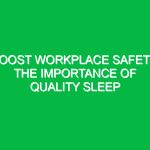Introduction
In the realm of Workplace Safety, few environments pose as significant a risk as confined spaces. Defined as areas that are not designed for continuous occupancy and have limited means of entry and exit, these spaces can include tanks, silos, tunnels, and pits. The control for confined space is crucial in the Health, Safety, and Environment (HSE) domain, primarily because of the potential Hazards that lurk within these seemingly innocuous locations. Understanding and implementing effective controls can mean the difference between life and death for workers in these environments. This article will delve into the essential controls necessary for ensuring Safety in confined spaces, drawing on real-world examples, best practices, and regulatory frameworks to provide a comprehensive overview.
Understanding Confined Space Hazards
Before discussing the controls necessary for confined spaces, it is essential to understand the potential hazards. Confined spaces may contain:
- Atmospheric Hazards: These include toxic gases, flammable vapors, and oxygen-deficient air. For instance, a worker entering a sewer may encounter methane gas, which is both flammable and asphyxiating.
- Physical Hazards: The design of a confined space often leads to physical dangers such as falling objects, sharp edges, and the risk of engulfment by materials like sand or grain.
- Environmental Hazards: These can include extreme temperatures or flooding, which can occur in spaces like underground vaults or storage tanks.
Recognizing these hazards is the first step towards establishing effective Control Measures. Without a thorough risk assessment, implementing Safety protocols can be akin to navigating a minefield blindfolded.
Key Controls for Confined Spaces
Implementing controls for Confined Space Safety is a multifaceted endeavor that encompasses various elements. Here are some of the vital controls that must be considered:
1. Risk Assessment
Conducting a thorough risk assessment is paramount before any work begins in a confined space. This process involves identifying potential hazards, evaluating the risks associated with those hazards, and determining appropriate Control Measures. A common tool used in this step is the Job Safety Analysis (JSA), which helps outline the specific tasks to be performed and associated risks.
2. Permit Systems
A Confined Space Entry Permit is an essential control mechanism. This formal document outlines the Procedures to be followed, the hazards identified, and the Safety Measures in place. It must be completed before any entry into the confined space and should include:
- The name of the authorized entrants.
- The specific hazards present.
- Required Personal Protective Equipment (PPE).
- Emergency procedures.
The permit system serves as a checkpoint, ensuring that all safety protocols are adhered to before work commences.
3. Ventilation
Proper ventilation is crucial in confined spaces to reduce or eliminate harmful atmospheric conditions. There are two primary types of ventilation:
- Natural Ventilation: This relies on wind or natural air currents to circulate fresh air into the confined space.
- Mechanical Ventilation: This involves the use of fans or blowers to actively introduce fresh air and remove contaminated air.
For example, in a chemical storage tank, mechanical ventilation might be necessary to ensure that volatile fumes are adequately diluted before entry.
4. Personal Protective Equipment (PPE)
PPE is another critical control component. The type of PPE required will vary based on the identified hazards. This might include:
- Respirators for toxic gas exposure.
- Hard hats to protect against falling objects.
- Protective clothing to prevent chemical Burns.
Choosing the right PPE is not just about compliance; it’s about ensuring that workers can perform their tasks safely and effectively.
5. Monitoring and Communication
Continuous monitoring of atmospheric conditions is vital in confined spaces. This can be achieved through the use of gas detection equipment that provides real-time readings of oxygen levels and the presence of hazardous gases. Furthermore, maintaining open lines of communication among team members is essential. Using two-way radios can help ensure that all workers are aware of any changes in the environment or emerging hazards.
6. Emergency Preparedness
No control for confined space would be complete without a robust emergency preparedness plan. This plan should outline specific procedures to follow in the event of an emergency, such as a worker becoming incapacitated or an atmospheric change. Regular drills and Training sessions should be conducted to ensure that all workers are familiar with emergency protocols.
Real-Life Examples and Case Studies
To illustrate the importance of these controls, let’s explore a few real-life incidents.
In 2010, a tragic incident occurred in a wastewater treatment facility in Massachusetts. Two workers entered a confined space without proper ventilation or monitoring. They quickly succumbed to toxic gases, leading to fatal consequences. This incident underscores the critical need for comprehensive risk assessments and a strong emphasis on ventilation and monitoring.
Conversely, a construction company implemented a robust confined space program that included thorough training, the use of gas detection equipment, and regular safety drills. As a result, they reported zero incidents over several years, proving that investing in safety controls pays off.
Regulations and Standards
Confined space safety is governed by various Regulations and standards. In the United States, the Occupational Safety and Health Administration (OSHA) has established guidelines under the Standard 29 CFR 1910.146, which outlines requirements for entering and working in confined spaces. Key components of this standard include:
- Identification of confined spaces.
- Development of a written permit system.
- Training requirements for workers.
Compliance with these regulations is not just a legal obligation but a moral imperative to protect workers’ lives.
Conclusion
The control for confined space is a critical component of health and safety management in any industry. By understanding the hazards, implementing effective controls, and adhering to regulations, organizations can significantly reduce the risk of accidents and fatalities. The importance of robust training, effective monitoring, and emergency preparedness cannot be overstated.
As we continue to unlock the safety secrets of confined spaces, it is vital for organizations to commit to ongoing education and improvement in their safety practices. The stakes are high, and the lives of workers depend on our diligence and commitment to safety. In the end, a proactive approach to confined space safety not only protects workers but enhances overall workplace morale and productivity.


